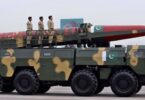ISLAMABAD (INP): Rescue and relief efforts continued in Sindh’s flood-hit Dadu district on Thursday, with water up to “eight to nine foot” in some places, according to an official, as Pakistanis brace for another spell of above-normal rains this month.
Abnormal heavy monsoon rains and melting glaciers triggered floods that have submerged a third of the country and killed at least 1,191 people, including 399 children since June 14, National Disaster Management Authority’s daily update showed. Twenty-seven more people died in the previous 24 hours. In Sindh’s Dadu district, parts of which have been inundated due to waters coming in from the north, Khairpur Nathan Shah has been the hardest hit so far.
“Flood water is standing eight to nine foot high in Khairpur Nathan Shah city,” Dadu District Commissioner Syed Murad Ali Shah told reporters. He added that the military and paramilitary Rangers were assisting relief efforts. “Rangers DG Major General Iftikhar Hassan and Brigadier Hasanat and Ijaz from the Pakistan Army are [leading] the relief operation,” Shah added.
He added that Johi, located at a distance of eight kilometres, had been cut off from Dadu city in the aftermath of flash floods. Some 60 kilometres north, residents of Mehar gathered to form new dikes and reinforce existing ones using sandbags near a major highway that was deluged by water overnight. “We have been working to make and reinforce this dike since early morning,” Damshad Ali, 20, told Reuters, vowing to stay in the flood-stricken area with his family. Nearby, another man called for help.
“I appeal to all young men to come join the dike strengthening, God willing we will save the city of Mehar from the flood waters,” he said from a mound of sandbags, as local residents joined the effort. A day ago, DC Shah had told that the water level was rising in the Main Nara Valley drain in Khairpur Nathan Shah and Johi talukas. Foreign Minister Bilawal Bhutto-Zardari also accompanied diplomats from over 20 countries on a flight over the flooded regions in Sindh yesterday and told them the province urgently needed Rs860 billion to reconstruct collapsed houses, repair roads and revive agriculture destroyed by unrelenting heavy rains and subsequent flooding.
As a result of the recent catastrophe, 24 districts with 102 talukas and 5,727 dehs have been declared calamity-hit in the province, Sindh Chief Minister Murad Ali Shah was told yesterday. Meanwhile, the World Health Organisation (WHO) has warned of a brewing health crisis, reporting that at least 888 health facilities have been damaged in rain-induced floods that have affected 116 out of 154 districts across the country.
Over 33 million people were affected out of which 6.4 million people, including 421,000 people displaced by floods, were in dire need of humanitarian aid, the WHO said. In KP’s Kohistan region, the residents of Dubair and Kandia complain of facing difficulties, saying that the two areas being disconnected from the rest of the country.
A resident of Upper Dubair, Hamesh Gul, spoke to while carrying his daughter on his shoulders, who he said had been suffering from cholera for the past week. He said the resident from these areas had to travel for four to five hours to access health facilities and upon reaching there, they would come to know most times that the facilities had run short of medicine. Khan said yesterday a woman died while being carried to a hospital in Bisham, Shangla on a charpoy.
Meanwhile, a statement by the Swat DC Office said efforts to rescue stranded tourists from Kalam and shift them to safer spots were afoot. The statement said the land route to the area had been cut off due to the damage caused to roads and bridges and over 4,000 tourists were stranded in Kalam and other areas. Helicopters of the Pakistan Army and KP government were being used for the rescue operation, the statement added. Separately, Qari Bilal, a social activist from Kalam, told Dawn.com that the area residents had begun reconstructing the Kalam road on a self-help basis as the “government has failed to start the [rehabilitation] work” so far.
In an update issued on Thursday, the military’s media affairs wing said so far, 157 army helicopter sorties had been flown to evacuate stranded individuals from flood-hit areas and transport rations. The Inter-Services Public Relations (ISPR) said 1,087 stranded individuals had been rescued thus far, while 72 tons of relief items had been delivered through army aviation.
“More than 50,000 individuals have been shifted to safer locations from calamity-hit areas,” the ISPR said, adding that over 51,000 patients had been treated at medical camps set up by the army, where free medicine doses for three to five days had been provided to patients. The military has established 221 relief item collection points across the country, according to the ISPR, and 1,231 tons of items have been collected and dispatched from these points. Moreover, 25,000 packs of ready-to-eat meals had been provided to flood-affected people.
The ISPR further said the Frontier Works Organisation, along with the National Highway Authority, had ensured the timely restoration of communication infrastructure, including the repair of the Karakoram Highway and Jaglot-Skardu Road. Engineer and medical troops/resources had been moved to Karachi to augment rescue/relief operations in Sindh, it added.
Meanwhile, the army’s flood control helplines – 1125 for KP and 1135 for the rest of Pakistan – remain functional. The ISPR statement also mentioned that Chief of Army Staff General Qamar Javed Bajwa would visit Dera Ismail Khan in KP and Rojhan in Punjab today. Given the scale of destruction and following appeals for assistance by the government, several nations have pledged support for Pakistan and the United Nations has launched a $160m flash appeal to help the country cope with floods.
On Wednesday, the Asian Deve-lopment Bank approved a grant of $3m and more international aid came in the form of food and equipment, particularly from Turkiye and China, and the United Arab Emirates (UAE) arrived in the flood-hit country. According to the govt official, as many as 16 consignments of relief goods and equipment were delivered.
In a related development, Prime Minister Shehbaz Sharif tweeted on Thursday that the UAE had begun the delivery of the first tranche of relief goods worth $50m. He added that he had held a telephone call with Emirati President Sheikh Mohammed bin Zayed al-Nahyan last night during which the UAE president had assured him of continued assistance for flood victims. In response to PM Shehbaz’s tweet, the UAE embassy in Pakistan said: “We affirm the commitment to stand by the people of Pakistan in the current challenges of floods, embodying the humanitarian role set by our founding father, Sheikh Zayed bin Sultan Al Nahyan, we thank the partners in Pakistan for their cooperation to deliver aid to the affectees.”
As the country reels from the deadly, devastating rains and floods, the Pakistan Meteorological Department (PMD) has forecast more rain in September. A Met Office forecast issued on Wednesday that La Nina conditions – responsible for recent spells of flood-triggering deluge in the country – would persist in September but become less intense. “Tendency for normal to above normal precipitation is likely over the country during September,” the Met Office said, predicting above-normal rainfall in northeastern Punjab and Sindh.
Meanwhile, most areas in Azad Kashmir, Khyber Pakhtunkhwa (KP) and Balochistan were expected to receive normal to slightly above normal rain, it added. Gilgit-Baltistan and northern areas of KP would witness “nearly normal rainfall” during the forecast period. As a result of these showers, the Met Office warned of potential flash flooding in the hilly areas of Punjab, Azad Jammu and Kashmir and KP and urban flooding in plain areas, which include main cities in Punjab, Sindh and KP. “But the likelihood [of flooding] remains lower as per climatology of the forecast month,” the Met Office said. It added that rains during September may have a “good impact” on the growth and vegetation of Kharif crops and sufficient water would be available for irrigation and power sectors.






